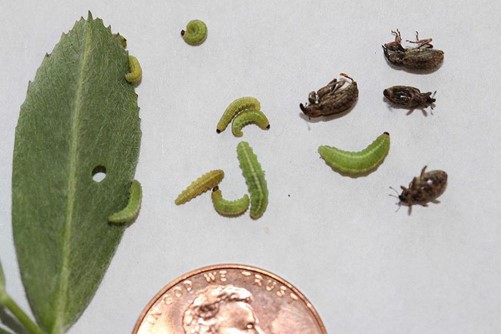![]()

By Dr. Pin-Chu Lai, Entomologist, Panhandle Research, Extension, and Education Center
John Thomas, Nebraska Extension Educator, Water and Cropping Systems
Gary Stone, Nebraska Extension Educator, Water and Cropping Systems
Alfalfa weevil has been an early season pest of the alfalfa forage crop in the Panhandle region reducing hay yield and quality. More recently, insecticide regulation and resistance brought new challenges to alfalfa weevil management. With the warmer temperatures we have had in the past few weeks and warmer temperatures on the way, producers should start scouting alfalfa fields for the alfalfa weevil now and in the coming weeks.
Alfalfa weevils overwinter as adults in plant debris around the fields and as eggs in the stems of alfalfa. Eggs will start hatching when 200-300 growing degree days (GDD; base 48° F) have accumulated since January 1. The weevil larvae progress through four instars, the first two instars chew holes in the upper leaves, while the third and fourth instars cause the most damage to the crop by feeding between leaf veins resulting in skeletonization or defoliation.
Scouting of fields is recommended to determine if management treatment is warranted. Proper scouting and identification are critical. Alfalfa weevil scouting can be done by using a sweep net or by cutting and shaking the stems in a bucket to count the number of larvae. Economic thresholds for alfalfa weevil larvae can be found at https://cropwatch.unl.edu/2021/scouting-advised-alfalfa-weevil
Two flushes of weevil larvae in the spring have been observed in the Panhandle and northern counties in recent years. Therefore, pay special attention to the alfalfa green-up and regrowth after first cutting. Feeding from both weevil larvae and adults can prevent regrowth from occurring. If regrowth does not begin within 4 or 5 days, scout for larvae or adults and treat the field as needed.
